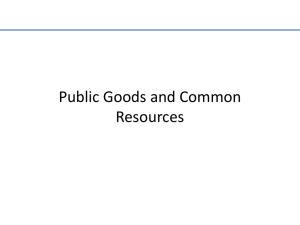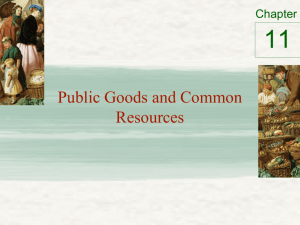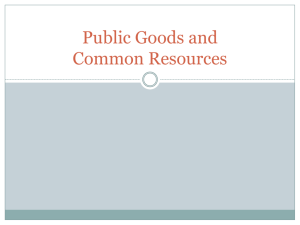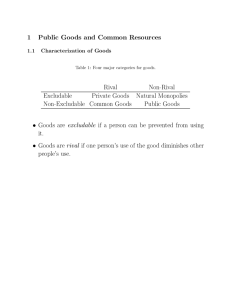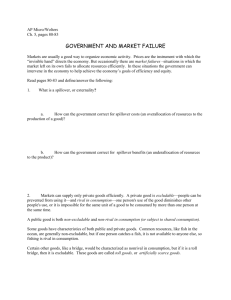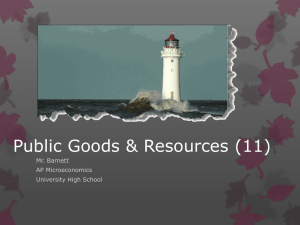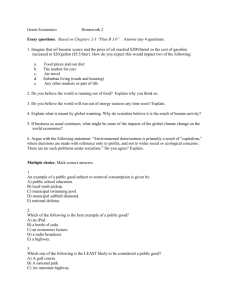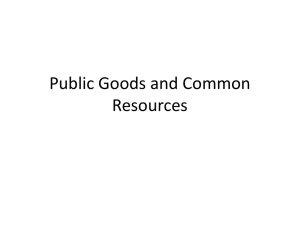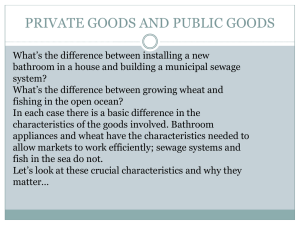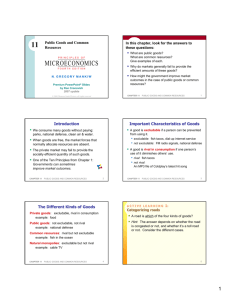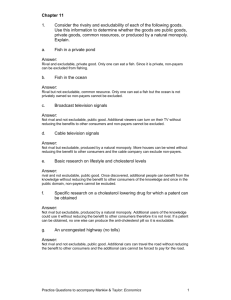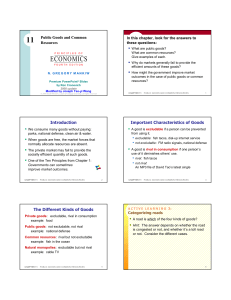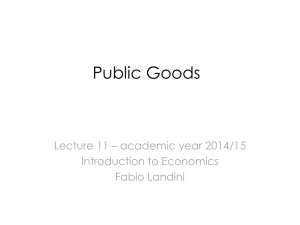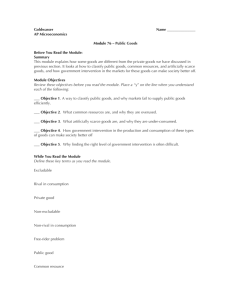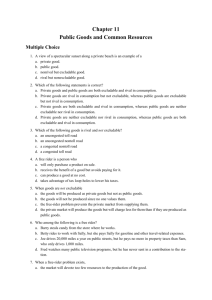Chapter 11 Public Goods and Common Resources
advertisement
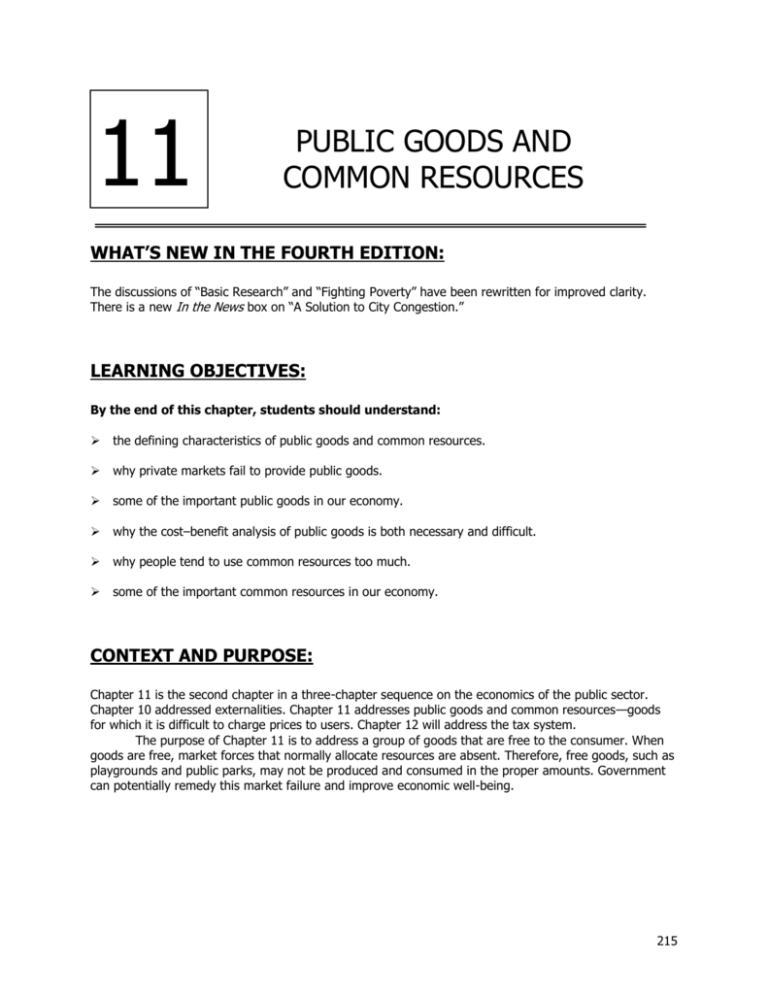
r 11 11 PUBLIC GOODS AND COMMON RESOURCES WHAT’S NEW IN THE FOURTH EDITION: The discussions of “Basic Research” and “Fighting Poverty” have been rewritten for improved clarity. There is a new In the News box on “A Solution to City Congestion.” LEARNING OBJECTIVES: By the end of this chapter, students should understand: the defining characteristics of public goods and common resources. why private markets fail to provide public goods. some of the important public goods in our economy. why the cost–benefit analysis of public goods is both necessary and difficult. why people tend to use common resources too much. some of the important common resources in our economy. CONTEXT AND PURPOSE: Chapter 11 is the second chapter in a three-chapter sequence on the economics of the public sector. Chapter 10 addressed externalities. Chapter 11 addresses public goods and common resources—goods for which it is difficult to charge prices to users. Chapter 12 will address the tax system. The purpose of Chapter 11 is to address a group of goods that are free to the consumer. When goods are free, market forces that normally allocate resources are absent. Therefore, free goods, such as playgrounds and public parks, may not be produced and consumed in the proper amounts. Government can potentially remedy this market failure and improve economic well-being. 215 216 Chapter 11/Public Goods and Common Resources KEY POINTS: 1. Goods differ in whether they are excludable and whether they are rival in consumption. A good is excludable if it is possible to prevent someone from using it. A good is rival in consumption if one person’s use of the good reduces other people’s ability to use the same unit of the good. Markets work best for private goods, which are both excludable and rival in consumption. Markets do not work as well for other types of goods. 2. Public goods are neither rival in consumption nor excludable. Examples of public goods include fireworks displays, national defense, and the creation of fundamental knowledge. Because people are not charged for their use of the public good, they have an incentive to free ride when the good is provided privately. Therefore, governments provide public goods, making their decision about the quantity based on cost–benefit analysis. 3. Common resources are rival in consumption but not excludable. Examples include common grazing land, clean air, and congested roads. Because people are not charged for their use of common resources, they tend to use them excessively. Therefore, governments try to limit the use of common resources. CHAPTER OUTLINE: I. The Different Kinds of Goods A. B. When classifying types of goods in the economy, two characteristics should be examined. 1. Definition of excludability: the property of a good whereby a person can be prevented from using it. 2. Definition of rivalry in consumption: the property of a good whereby one person’s use diminishes other people’s use. Using these two characteristics, goods can be divided into four categories. Figure 1 1. Definition of private goods: goods that are both excludable and rival in consumption. 2. Definition of public goods: goods that are neither excludable nor rival in consumption. 3. Definition of common resources: goods that are rival in consumption but not excludable. 4. If a good is excludable but not rival in consumption, it is an example of a natural monopoly. Chapter 11/Public Goods and Common Resources 217 C. The boundary between the categories is sometimes fuzzy. Whether goods are excludable or rival in consumption is often a matter of degree. Yes Excludable? No D. II. Rival in consumption? Yes No Private Goods Natural Monopolies ice-cream cones fire protection clothing cable TV congested toll roads uncongested toll roads Common Resources Public Goods fish in the ocean national defense the environment knowledge congested nontoll roads uncongested nontoll roads Public goods and common resources each create externalities because they have value yet have no price because they are not sold in the marketplace. These external effects imply that market outcomes will be inefficient in the absence of government involvement or private resolutions to correct the externality. Public Goods A. Example: a fireworks display. It is not excludable because it would be nearly impossible to keep others from viewing it and it is not rival in consumption because one person’s enjoyment does not preclude others from enjoying the fireworks. B. The Free-Rider Problem 1. It would be difficult to sell tickets to the fireworks show because it is not excludable. 2. Thus, some individuals would get a benefit from the show without paying for it. 3. Definition of free rider: a person who receives the benefit of a good but avoids paying for it. 4. More than likely, private individuals or firms will not produce the fireworks show because it would not be profitable. 5. If the social value of the fireworks show is greater than the cost of producing it, it would be efficient for the fireworks show to be produced. 6. a. The local government can sponsor the show and charge each of its citizens with part of the cost (in the form of a tax). b. If the tax is less than the value of the fireworks display to each individual, everyone is better off. This is another demonstration of Principle #7: Governments can sometimes improve market outcomes. 218 Chapter 11/Public Goods and Common Resources C. D. E. Some Important Public Goods 1. National defense 2. Basic research 3. Programs to fight poverty Case Study: Are Lighthouses Public Goods? 1. Lighthouses are used so that ships can mark specific locations and avoid treacherous waters. 2. Use of a lighthouse is both nonexcludable and nonrival in consumption. 3. Thus, most lighthouses are provided by the government. 4. In 19th-century England, lighthouses were operated more like private goods. The owners of local ports were charged with the service and if they did not pay, the owner of the lighthouse simply turned off the light and ships avoided stopping in that port. The Difficult Job of Cost–Benefit Analysis 1. To decide whether or not it should fund a public good, the government must conduct a study of the total benefits and costs of the good. 2. Definition of cost-benefit analysis: a study that compares the costs and benefits to society of providing a public good. 3. This is very difficult to do, because measuring how much individuals will value a specific good is problematic. a. Quantifying benefits is difficult using the results from a questionnaire. b. Respondents have little incentive to tell the truth. 4. This difficulty implies that the efficient supply of public goods is much more challenging than the efficient supply of private goods, because buyers of the private good reveal its value to the sellers. 5. Case Study: How Much Is a Life Worth? a. Example: the decision to place a stoplight at a busy intersection to reduce the risk of fatal accidents. b. The cost is known in dollar terms. But how can we put the value of a life in dollar terms? Chapter 11/Public Goods and Common Resources 219 III. c. Some studies examine the value of the lifetime earnings the individual could have made, but this implies that the life of someone who is disabled or retired has no monetary value. d. Economists instead may look at the risks that individuals voluntarily take and those that they require compensation for. Workers in risky occupations are paid a wage premium to take these risks. This approach gives us an idea of the value that an individual places on his or her life. Studies have shown this value to be approximately $10 million. Common Resources A. Common resources are not excludable, but they are rival in consumption. This implies that policymakers need to be concerned about how much is used. B. The Tragedy of the Commons C. 1. Definition of the Tragedy of the Commons: a parable that illustrates why common resources get used more than is desirable from the standpoint of society as a whole. 2. Example: small, medieval town where sheep graze on common land. a. Over time, as the population grows, so does the number of sheep. b. Given the fixed amount of land, the grass will begin to disappear because it is being overgrazed. c. The townspeople will no longer be able to raise sheep because the private incentives (using the land for free) outweigh the social incentives (using the land carefully). d. This problem could have been prevented if the town had regulated the number of sheep each farmer could have or auctioned off the right to use the common land for grazing. Alternatively, the town could have divided the common property between its citizens, thus turning the land into an excludable commodity. Some Important Common Resources 1. Clean air and water 2. Congested roads a. 3. In the News: A Solution to City Congestion — London recently adopted a policy that charges drivers who use busy roads during peak times. Fish, Whales, and Other Wildlife a. Case Study: Why the Cow is Not Extinct – Elephants in Africa are common resources because no one owns them. This means that no one has an incentive to make sure that a sufficient number are preserved. This is different from a cow, which is usually owned by a rancher. The 220 Chapter 11/Public Goods and Common Resources rancher has an incentive to ensure that the cattle population on his ranch is maintained so that he can continue to earn a profit. Thus, governments could actually be more successful in making sure that the elephant is not extinct by allowing people to kill the elephants on their own property (thus making the elephants a private good). The landowners would then have some incentive to preserve the stock of elephants on their land. b. IV. In the News: Should Yellowstone Charge as Much as Disney World? – National parks are somewhat of a common resource and can be overused. This is an article from The New York Times suggesting that congestion in national parks could be solved by raising the entrance fees. Conclusion: The Importance of Property Rights A. With both public goods and common resources, the market outcome will be inefficient because of the lack of well-defined property rights. B. This absence of property rights can lead to a market failure, which implies that in these situations, governments can improve the allocation of resources and increase economic well-being.
